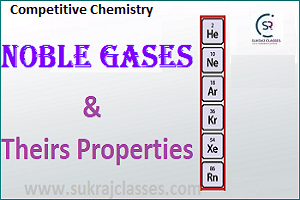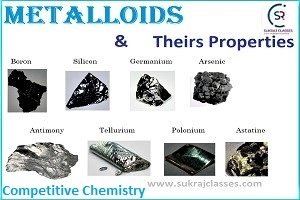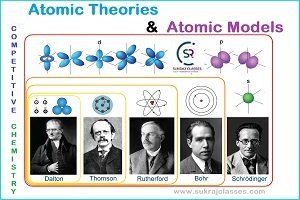
Noble Gases and Their Properties – Competitive Chemistry
Competitive Chemistry topic – “Noble Gases and Their Properties”, is important for all competitive exams like CET- Common eligibility Test, SSC CGL, SSC CHSL, RRB NTPC, UPSC and for other state civil service exams. In these exams, almost 4-5 Questions are coming from Chemistry. Let’s start the topic:
Noble Gases and Their Properties:
- Helium, Neon, Argon, Krypton, Xenon and Radon are known as Inert Gases or Noble Gases.
- These elements are all in group 18 of the periodic table
- These are always found in the free-state but radon is not present in nature in free-State.
- Noble gases’ outer shells are full, they are very inert and stable. This means they don’t tend to react with other elements to form compounds.
- They are full outer shell of electrons. Helium has two electrons in its outer shell and the rest have eight electrons.
- All of them are monoatomic, meaning each molecule is a single atom.
- They are gases under standard conditions.
- They are colorless and odourless.
- Their melting and boiling points are close together giving them a very narrow liquid range.
- In the atmosphere, argon is the most abundant noble gas but in the universe, helium is the most abundant gas.
- The mixture of Helium and Oxygen is used for artificial breathing of Asthma patients and by sea drivers.
- Helium is used as a pressuring agent in rockets to expel liquid oxygen and liquid hydrogen.
- Neon is second lightest noble gases, only helium is lighter than neon.
- Neon is used in a neon discharge lamp and signs for advertising purposes.
- Neon can be liquefied and used as a cryogenic refrigerant
- Xenon is also known as stranger gas and a combined mixture of xenon and krypton is used in high-intensity photographic ash tubes.
- Radon is used in the preparation of an ointment for the treatment of cancer.
- Argon is the 3rd most abundant gas found in the Earth’s atmosphere.
- A mixture of argon and nitrogen is used in an electric bulb.
- Krypton is used in high-efficiency miner’s cap lamps.
Helium:-
-
-
- Name: Helium
- Symbol: He
- Atomic Number: 2
- Atomic Weight: 4.002602 u
-
- Helium is a gas at room temperature.
- Helium is a non-toxic gas that is odourless, tasteless and colorless.
- Helium is named after Helios, the Greek Titan of the Sun.
- Helium is the 2nd lightest element on the periodic table and Lightest among all the inert gases.
- Helium is the 2nd most abundant element found in the universe, but it considered rare on Earth.
- While helium is abundant throughout the universe, Most of the helium found on Earth was formed from radioactive decay.
- Helium is in the noble gas group (18) on the periodic table.
- Helium has two stable isotopes: Helium-3 (3H) and Helium-4 (4H).
- Helium is filled in ‘Tyres of aeroplane’ due to its non- combustion nature.
- Helium is filled in the oxygen cylinder of scuba-driver.
- Helium is also filled in oxygen-cylinder of asthmatic patients.
Fact: – In general oxygen cylinder which use in hospitals etc. nitrogen gas is mixed with oxygen (pure oxygen may be blast, in human body).
Use of Helium Gas:-
- Helium gas used in tourist balloons, because helium is lighter than air, it can give things lift
- Helium dating is a processed used to determine the age of rocks and materials.
- It is used in cryogenic applications.
Neon : –
-
-
- Name: Neon
- Symbol: Ne
- Atomic Number: 10
- Atomic Weight: 20.179 u
-
- Neon is a gas at room temperature.
- Neon is a colorless and odourless gas.
- Neon is in the noble gas element category on the periodic table.
- “William Ramsay and Morris” first isolated and discovered to neon in 1898.
- Neon has three stable isotopes and they are 20Ne, 21Ne and 22Ne.
- Neon is the 5th most abundant element found in the universe.
- A trace amounts of neon is present in the Earth’s atmosphere.
- Neon is about two-thirds denser than air.
- Neon is second lightest noble gases, only helium is lighter than neon.
Use of Neon gas:-
- Neon can be liquefied and used as a cryogenic refrigerant.
- It is used for manufacturing high-voltage indicators, television tubes, wave meter tubes switching gear, lightning arresters, diving equipment
- The reddish-orange color emitted from the neon lights are used for advertising purposes
- It is combined with helium to produce helium-neon lasers.
Argon:-
-
-
- Name: Argon
- Symbol: Ar
- Atomic Number: 18
- Atomic Weight: 39.948 u
-
- Argon is a gas at room temperature.
- Argon is a colorless, odourless, and tasteless gas.
- Argon is a group 18 (noble gases group) chemical element. So, argon is noble gas.
- British scientist John W. Strutt and Scottish chemist William Ramsay discovered and isolated to argon.
- Argon has three stable isotopes: 36Ar, 38Ar and 40Ar.
- Over 99% of the natural argon found on Earth is 40Ar.
- Argon is the 3rd most abundant gas found in the Earth’s atmosphere.
- Argon is denser than air.
- Argon’s density makes it a great insulator and is injected in between double pan windows.
- Argon is added into incandescent light bulbs to protect the filament from oxidation.
Use of Argon Gas:-
- A mixture of argon and nitrogen is used in an electric bulb
- Argon lasers are used in the treatment of retinal detachment and retinal phototherapy for those who are diabetic
- It is also used in surgeries to weld arteries and destroy tumours.
- In the medical field, it is mainly use in argon laser system, as it is capable of targeting areas with extreme precision.
Xenon:-
-
-
- Name: Xenon
- Symbol: Xe
- Atomic Number: 54
- Atomic Weight:293 u
-
- Xenon is a gas at room temperature.
- Xenon is a dense noble gas
- Xenon is odourless and colorless. However, it does exhibit bright blue glow when placed inside an electric field.
- Scottish chemist William Ramsay and English chemist Morris Travers discovered and first isolated to xenon.
- Xenon is in the noble gas element category on the periodic table.
- Xenon is a group 18 chemical element, which is the noble gases group.
- Xenon has Isotopes 124Xe, 126Xe, 128Xe, 129Xe, 130Xe, 131Xe, 132Xe, 134Xe and 136
- Xenon is found in the Earth’s atmosphere at trace amount about 1 part per 11.5 million.
- Xenon has been detected in gases emitted from some mineral springs.
Use of xenon: –
- Xenon is used in medicine as a general anesthetic and in medical imaging.
- It is used in Flash lamps called Xenon flash-lamps.
- It is also used in photographic flashes.
- It is used to measure the flow of blood and also used to image the Brain, Heart, and Lungs.
- Also, the element is used in NMR spectroscopy
- Xenon is also used in high pressure arc lamps for motion picture projection, and in high pressure arc lamps to produce ultraviolet light.
Krypton:-
-
-
- Name: Krypton
- Symbol: Kr
- Atomic number: 36
- Atomic weight: 798
-
- This noble gas is colourless and odourless.
- It has a full outer shell of electrons.
- Krypton is one of the rarest gases on Earth, composing only 1 part per million of the atmosphere by volume.
Use of Krypton gas:-
- The gas is used into some incandescent lightbulbs.
Radon:-
-
-
- Name: Radon
- Symbol:Rn
- Atomic number:86
- Atomic weight: 222
-
- Radon is classified as a noble gas, itis a gas at room temperature.
- Radon is a colourless and odourless gas.
- Radon was first detected as an emission from the radioactive decay of radium.
- Radon is rare in nature
- It is the densest noble gas.
- It is highly radioactive and chemically unreactive.
Use of Radon Gas:-
- Small amounts of radon are sometimes used by hospitals to treat some forms of cancer.
- Radon is also used in radiation therapy.
For More:
If you like and think that General Science (Chemistry) topic on “Noble Gases and Their Properties” was helpful for you, Please comment us. Your comments/suggestions would be greatly appreciated. Thank you to be here. Regards – Team SukRaj Classes.





